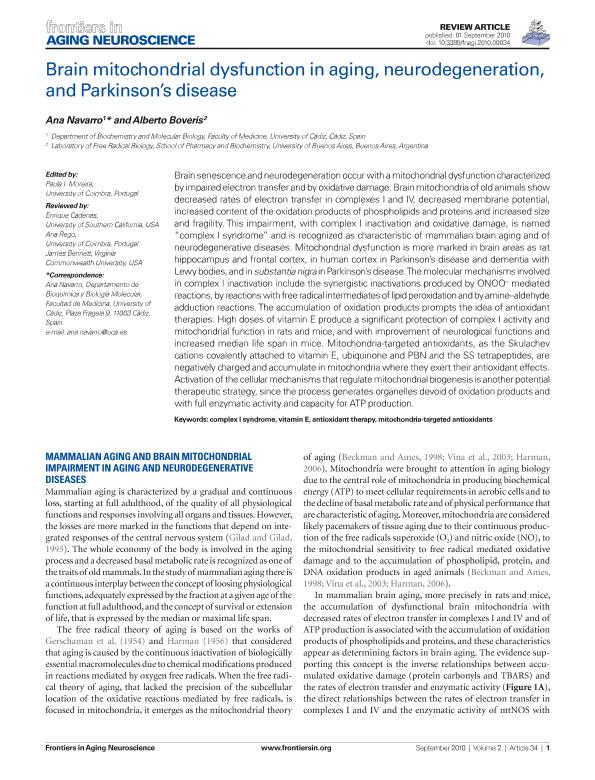Mostrar el registro sencillo del ítem
dc.contributor.author
Navarro, Ana

dc.contributor.author
Boveris, Alberto Antonio

dc.date.available
2017-05-10T21:37:16Z
dc.date.issued
2010-09
dc.identifier.citation
Navarro, Ana; Boveris, Alberto Antonio; Brain mitochondrial dysfunction in aging, neurodegeneration, and Parkinson’s disease; Frontiers; Frontiers in Aging Neuroscience; 2; 34; 9-2010; 1-11
dc.identifier.issn
1663-4365
dc.identifier.uri
http://hdl.handle.net/11336/16258
dc.description.abstract
Brain senescence and neurodegeneration occur with a mitochondrial dysfunction characterized by impaired electron transfer and by oxidative damage. Brain mitochondria of old animals show decreased rates of electron transfer in complexes I and IV, decreased membrane potential, increased content of the oxidation products of phospholipids and proteins and increased size and fragility. This impairment, with complex I inactivation and oxidative damage, is named “complex I syndrome” and is recognized as characteristic of mammalian brain aging and of neurodegenerative diseases. Mitochondrial dysfunction is more marked in brain areas as rat hippocampus and frontal cortex, in human cortex in Parkinson's disease and dementia with Lewy bodies, and in substantia nigra in Parkinson's disease. The molecular mechanisms involved in complex I inactivation include the synergistic inactivations produced by ONOO− mediated reactions, by reactions with free radical intermediates of lipid peroxidation and by amine–aldehyde adduction reactions. The accumulation of oxidation products prompts the idea of antioxidant therapies. High doses of vitamin E produce a significant protection of complex I activity and mitochondrial function in rats and mice, and with improvement of neurological functions and increased median life span in mice. Mitochondria-targeted antioxidants, as the Skulachev cations covalently attached to vitamin E, ubiquinone and PBN and the SS tetrapeptides, are negatively charged and accumulate in mitochondria where they exert their antioxidant effects. Activation of the cellular mechanisms that regulate mitochondrial biogenesis is another potential therapeutic strategy, since the process generates organelles devoid of oxidation products and with full enzymatic activity and capacity for ATP production.
dc.format
application/pdf
dc.language.iso
eng
dc.publisher
Frontiers

dc.rights
info:eu-repo/semantics/openAccess
dc.rights.uri
https://creativecommons.org/licenses/by-nc-sa/2.5/ar/
dc.subject
Complex I Syndrome
dc.subject
Vitamin E
dc.subject
Antioxidant Therapy
dc.subject
Mitochondria-Targeted Antioxidants
dc.subject.classification
Bioquímica y Biología Molecular

dc.subject.classification
Ciencias Biológicas

dc.subject.classification
CIENCIAS NATURALES Y EXACTAS

dc.title
Brain mitochondrial dysfunction in aging, neurodegeneration, and Parkinson’s disease
dc.type
info:eu-repo/semantics/article
dc.type
info:ar-repo/semantics/artículo
dc.type
info:eu-repo/semantics/publishedVersion
dc.date.updated
2017-05-10T19:59:32Z
dc.journal.volume
2
dc.journal.number
34
dc.journal.pagination
1-11
dc.journal.pais
Suiza

dc.journal.ciudad
Laussane
dc.description.fil
Fil: Navarro, Ana. Universidad de Cádiz; España
dc.description.fil
Fil: Boveris, Alberto Antonio. Universidad de Buenos Aires. Facultad de Farmacia y Bioquímica; Argentina. Consejo Nacional de Investigaciones Científicas y Técnicas; Argentina
dc.journal.title
Frontiers in Aging Neuroscience
dc.relation.alternativeid
info:eu-repo/semantics/altIdentifier/url/http://journal.frontiersin.org/article/10.3389/fnagi.2010.00034/full
dc.relation.alternativeid
info:eu-repo/semantics/altIdentifier/doi/http://dx.doi.org/10.3389/fnagi.2010.00034
dc.relation.alternativeid
info:eu-repo/semantics/altIdentifier/url/https://www.ncbi.nlm.nih.gov/pmc/articles/PMC2947925/
Archivos asociados
